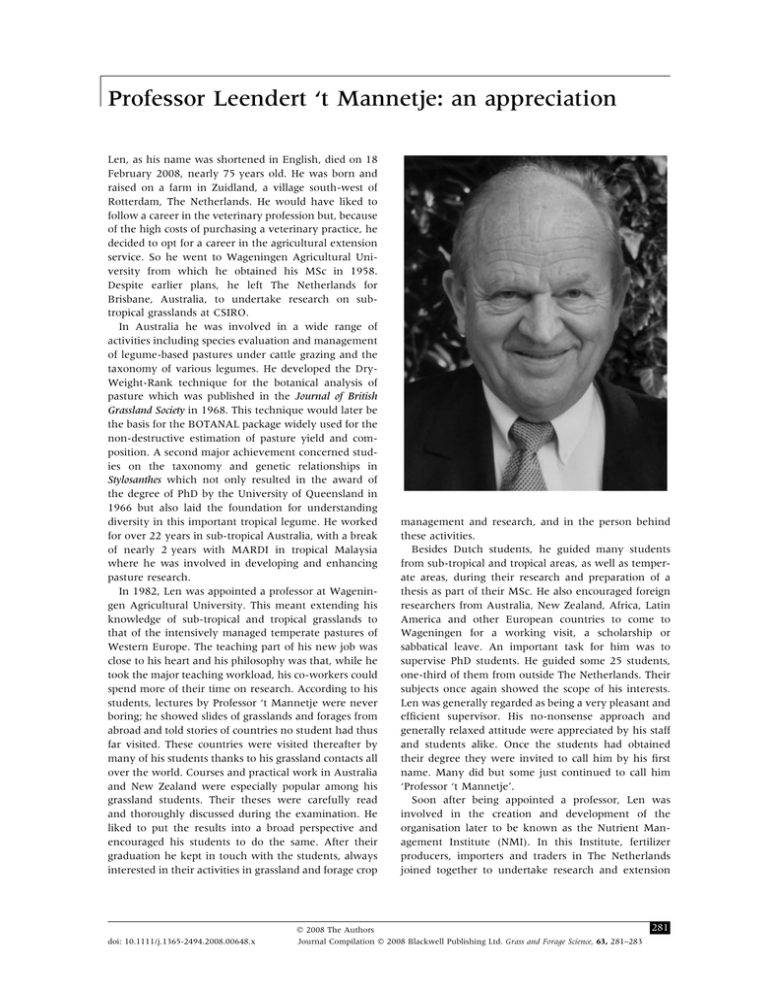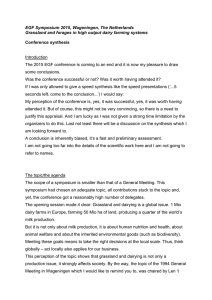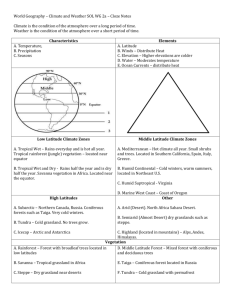Professor Leendert ‘t Mannetje: an appreciation
advertisement

Professor Leendert ‘t Mannetje: an appreciation Len, as his name was shortened in English, died on 18 February 2008, nearly 75 years old. He was born and raised on a farm in Zuidland, a village south-west of Rotterdam, The Netherlands. He would have liked to follow a career in the veterinary profession but, because of the high costs of purchasing a veterinary practice, he decided to opt for a career in the agricultural extension service. So he went to Wageningen Agricultural University from which he obtained his MSc in 1958. Despite earlier plans, he left The Netherlands for Brisbane, Australia, to undertake research on subtropical grasslands at CSIRO. In Australia he was involved in a wide range of activities including species evaluation and management of legume-based pastures under cattle grazing and the taxonomy of various legumes. He developed the DryWeight-Rank technique for the botanical analysis of pasture which was published in the Journal of British Grassland Society in 1968. This technique would later be the basis for the BOTANAL package widely used for the non-destructive estimation of pasture yield and composition. A second major achievement concerned studies on the taxonomy and genetic relationships in Stylosanthes which not only resulted in the award of the degree of PhD by the University of Queensland in 1966 but also laid the foundation for understanding diversity in this important tropical legume. He worked for over 22 years in sub-tropical Australia, with a break of nearly 2 years with MARDI in tropical Malaysia where he was involved in developing and enhancing pasture research. In 1982, Len was appointed a professor at Wageningen Agricultural University. This meant extending his knowledge of sub-tropical and tropical grasslands to that of the intensively managed temperate pastures of Western Europe. The teaching part of his new job was close to his heart and his philosophy was that, while he took the major teaching workload, his co-workers could spend more of their time on research. According to his students, lectures by Professor ‘t Mannetje were never boring; he showed slides of grasslands and forages from abroad and told stories of countries no student had thus far visited. These countries were visited thereafter by many of his students thanks to his grassland contacts all over the world. Courses and practical work in Australia and New Zealand were especially popular among his grassland students. Their theses were carefully read and thoroughly discussed during the examination. He liked to put the results into a broad perspective and encouraged his students to do the same. After their graduation he kept in touch with the students, always interested in their activities in grassland and forage crop doi: 10.1111/j.1365-2494.2008.00648.x management and research, and in the person behind these activities. Besides Dutch students, he guided many students from sub-tropical and tropical areas, as well as temperate areas, during their research and preparation of a thesis as part of their MSc. He also encouraged foreign researchers from Australia, New Zealand, Africa, Latin America and other European countries to come to Wageningen for a working visit, a scholarship or sabbatical leave. An important task for him was to supervise PhD students. He guided some 25 students, one-third of them from outside The Netherlands. Their subjects once again showed the scope of his interests. Len was generally regarded as being a very pleasant and efficient supervisor. His no-nonsense approach and generally relaxed attitude were appreciated by his staff and students alike. Once the students had obtained their degree they were invited to call him by his first name. Many did but some just continued to call him ‘Professor ‘t Mannetje’. Soon after being appointed a professor, Len was involved in the creation and development of the organisation later to be known as the Nutrient Management Institute (NMI). In this Institute, fertilizer producers, importers and traders in The Netherlands joined together to undertake research and extension Ó 2008 The Authors Journal Compilation Ó 2008 Blackwell Publishing Ltd. Grass and Forage Science, 63, 281–283 281 282 W. H. Prins and A. Elgersma work. At first he was chairman of the Board of NMI and, after its independence, he became a delegate supervisory board member. For over 20 years he was a critical reviewer of the agricultural and environmental work of NMI and took a special interest in the weal and woes of its staff. Len encouraged collaboration between Dutch and UK research, particularly on nitrogen utilization. He played a lead role in organizing discussion meetings and pooling of information and ideas between the Institute of Grassland and Environmental Research in the UK and Institutes and Universities in The Netherlands in the period from 1984 to 1989. It was largely through Len’s initiative that this group was invited to prepare and present a series of papers on Nitrogen Cycling at the 13th General Meeting of the European Grassland Federation (EGF) in Banska Bystrica, Czechoslovakia, in 1990. Five papers were presented on different aspects, with four of them having joint UK–Netherlands authorship. This initiative had a major impact on thinking in Europe and on the techniques used in this area of research. Len used to encourage contact and collaboration wherever he went, and this was a very concrete result from his efforts. In 1994, he chaired the 15th General Meeting of EGF in Wageningen. With colleagues, he established for the first time a peerreview process for all plenary and offered papers and arranged such a system for future conferences of EGF, with the proceedings appearing as volumes in the new series Grassland Science in Europe. As Head of the Department of Grassland Science, he was involved in management tasks which he fulfilled dutifully. When later the three chairs of Tropical Agriculture, Arable Crops and Grassland Science were merged to become the Department of Agronomy, Len became its first Head. However, as a result of a change in university policies, he was offered early retirement. The impact that he had made through his teaching and research at Wageningen University was recognized by the publication of Grassland Science in Perspective by fellow scientists on his retirement in 1996. He was the last professor in Grassland Science to be appointed by Wageningen University. His retirement gave Len the opportunity to spend more time on research as well as consultancy, with a preference for tropical grasslands. Thus he practised what he had always preached: as a scientist you should continue to learn. His new activities included research on a new classification of Stylosanthes at the Royal Botanical Gardens in Kew, UK. He had strong views on the use of molecular work alone for this badly needed new classification which, unfortunately, he could not finish. However, on the basis of classical taxonomic research, he was able together with B.L. Maass to establish S. seabrana as a new species from Brazil. He often travelled to tropical America to undertake consultancy where he was involved in a large on-farm research project carried out by teams of scientists of universities and research institutes of Colombia, Costa Rica and The Netherlands. The objective of this longterm project was to improve livestock productivity and farm income, as well as to study the sequestering and storing of carbon in the soil in comparison with that of adjacent forest and degraded lands. He was also involved in the training of graduate students and research staff in the participating organizations as well as at Yucatan University in Mexico. After his retirement Len continued to attend international grassland and rangeland congresses as well as the annual conferences of the EGF and the Netherlands Society of Grassland and Forage Crops. He could not hold back from participating in discussions, always giving forthright opinions, many of which had their origin in his farming background. Also outside the conference room he was not afraid to speak up for the farmers who should not be criticized but supported in their efforts to protect their crops or to use proven species to improve the pastures. For the XX International Grassland Congress of 2005 in Ireland and UK he was co-editor of the volume of Offered Papers. For many years he served on the Editorial Advisory Boards of Tropical Grasslands and Grass and Forage Science. He was a member of the Governing Body of the Institute of Grassland and Environmental Research from 1996 to 2002 and made a full contribution to steering the development of this major Institute with its main centres at Aberystwyth and North Wyke. During this period he was the only Governor from outside the UK. Len was well known in the world of grassland and his achievements were recognized. He was appointed a Fellow of the Australian Institute of Agricultural Science, a Fellow of the Tropical Grassland Society of Australia and received a Honorary Doctorate from the University of Debrecen, Hungary. Because of his scientific as well as organizational involvement for the EGF, he was appointed an Honorary Life President in 2002. Len was a prolific writer of research papers, review papers and chapters for books. His knowledge and experience came to good use when he edited the wellknown book on Measurement of Grassland Vegetation and Animal Production, which was first published in 1978 and reprinted in 1982 and 1987. Together with R.M. Jones he edited a new book on this topic, entitled Field and Laboratory Methods for Grassland and Animal Production Research which was published in 2000. In total he produced about 135 scientific papers, nearly a fifth of which were written after his retirement. He edited and co-edited six books, three of which were after his retirement. He presented the findings of his last book on Carbon Sequestration in Tropical Grassland Ecosystems, Ó 2008 The Authors Journal Compilation Ó 2008 Blackwell Publishing Ltd. Grass and Forage Science, 63, 281–283 Professor Leendert ‘t Mannetje: an appreciation 283 based on on-farm research in Columbia and Costa Rica, at a Book Launching Seminar at FAO Headquarters, Rome, in January 2008. This illustrates that Len was still active at the end of a career in grassland research of 50 years. He is sorely missed by his family, friends, students and colleagues. Ó 2008 The Authors Journal Compilation Ó 2008 Blackwell Publishing Ltd. Grass and Forage Science, 63, 281–283 W. H. Prins and A. Elgersma






